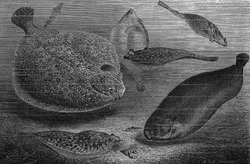Flatfish
|
|
| Flatfish | ||||||||
|---|---|---|---|---|---|---|---|---|
 19th c. engraving depicting several types of flatfish | ||||||||
| Scientific classification | ||||||||
| ||||||||
| Families | ||||||||
|
Suborder Psettodoidei |
The flatfish are an order (Pleuronectiformes) of ray-finned fish, also called the Heterosomata, sometimes classified as a suborder of Perciformes. The name means "side-swimmers" in Greek. In many species both eyes lie on one side of the head, one or the other migrating through and around the head during development. Some species face their "left" side upward, some face their "right" side upward, and others face either side upward.
Many important food fish species are in this order, including the Dover sole, flounder, turbot, sole, plaice and halibut. There are more than 400 species of this order. Some flatfishes can camouflage themselves on the ocean floor.
Flatfish have been cited as examples in favor of the theory of evolution. For example, Richard Dawkins in The Blind Watchmaker, states the proposed evolutionary history as follows: "...bony fish [generally] have a marked tendency to be flattened in a vertical direction...It was natural, therefore, that when the ancestors of [flatfish] took to the sea bottom, they should have lain on one side... But this raised the problem that one eye was always looking down into the sand... In evolution this problem was solved by the lower eye 'moving' round to the upper side." The development of flatfish is thus considered to recapitulate their evolutionary history.
The asymmetric geometry of flatfish has been likened to the cubist paintings of Pablo Picasso, and is often perceived as being "imperfect", "grotesque", "strange", etc. It is likely that the asymmetry contributes to their survival by helping to disguise them on the ocean floor.de:Plattfische fa:کوشکماهیان lt:Plekšniažuvės nl:Platvis ja:カレイ目
